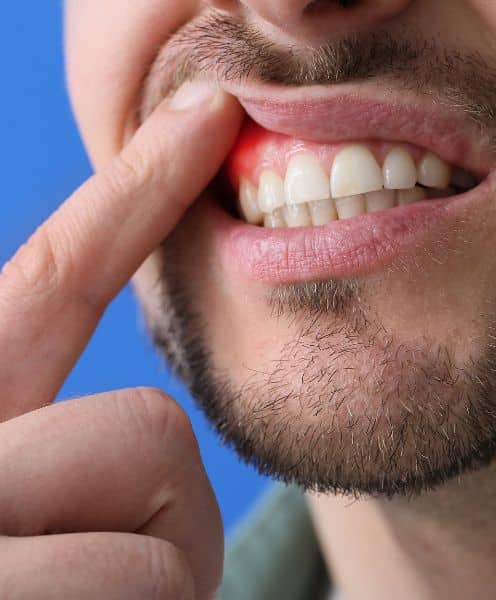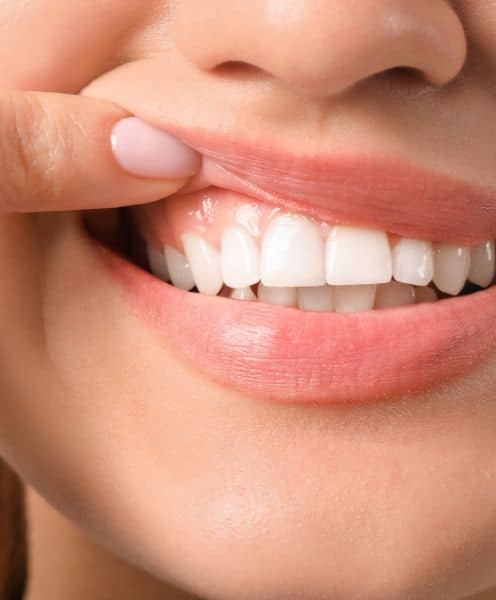
Gum Graft Surgery in Odessa, FL
BOOK APPOINTMENT ONLINETREATING GUM RECESSION WITH GUM GRAFTING IN ODESSA, FL
A changing tooth appearance, and increased spacing between your teeth, may have you closely scrutinizing your gum line the next time you brush and floss. If you notice red, swollen gums that are accompanied by loose teeth, bleeding, or sensitivity to hot and cold, then you may be experiencing gum thinning or gum recession. This is a common dental problem that is treated with gum grafting, a surgical procedure that replaces the lost tissue around your teeth. Gum recession must be treated, as it can lead to infections, decay, and tooth loss.
CONTACT US
WHAT ARE THE CAUSES OF GUM THINNING?
While gum thinning is commonly seen in adults over the age of 40, it can present in younger individuals if there is:
- Brushing too hard for long periods.
Using a hard-bristled toothbrush instead of a soft one. - Having poor dental hygiene and plaque build-up.
- Using tobacco or smoking.
- Are in the late stages of gum disease – periodontitis.
- Have misaligned teeth, tongue piercings, or damage from previous dental work.
- It can also be hereditary.
If it is determined that you need gum grafting to correct your receding gums, then one of our periodontists will measure the pockets around your teeth to see how much recession there is and check the overall health of your gums.
From here, we’ll recommend a specific type of gum graft and outline the next steps in a consultation.

WHY HAVE GUM GRAFT SURGERY DONE?
There are several issues that can develop if receding gums are left untreated, including susceptibility to cavities, infections, tooth sensitivity, and gum disease. By having a gum graft done, all of these risks are considerably reduced, plus the gum graft will help enhance your smile.

THE 3 TYPES OF GUM GRAFTS AVAILABLE
When treating receding gums, there are 3 gum grafting options available. The one that is recommended to you will be dependent on how severe the gum recession is.
- A Free Gingival Gum Graft is the most common type of graft and is used to treat mild to moderate recession. This involves taking a small amount of tissue from the roof of your mouth and placing it over the receded area. The tissue is then stitched into place to encourage growth and healing.
- A Connective Tissue Gum Graft is used to treat more severe recession and involves opening up a flap in the roof (palate) of your mouth, and taking a small amount of connective tissue from just underneath. This tissue is then placed over the receded area and stitched into place.
- A Pedicle Gum Graft is used to treat mild to moderate recession and involves creating a small flap of tissue in the gum line next to the affected tooth, and using it to cover over the top of the receding gum tissue. This type of gum grafting is the most successful, as no blood flow is cut off anywhere in the mouth, but only works if gum recession is isolated to one area.
If you only need 1 gum graft done, the appointment takes up to 60 minutes, but if you need several done, it could take quite a bit longer.

WHAT TO EXPECT DURING GUM GRAFTING SURGERY?
When heading into gum grafting surgery with one of our specialists, you can expect the following steps to take place:
- Local Anesthesia: gum grafting is done under local anesthesia, which numbers the teeth and gums in the area where you’ll be receiving the graft. If you’re an individual with dental anxiety, there are sedation dentistry options available, such as: nitrous oxide, oral sedation, and IV sedation. All of these options will ensure you don’t feel any pain.
- Site Prep With Small Incisions: once the local anesthesia has kicked in, the site that will receive the gum graft is prepared. During this stage, a small incision will be used to create a small flap in your gums, and the roots of your tooth will be cleaned thoroughly to ensure there is no infection.
- The Gum Graft is Harvested: in this step, our specialist will make another incision either in the roof of your mouth or along another area of your gum line and remove a small wedge of tissue. Once the wedge of tissue has been harvested successfully, stitches are used to close up the harvest site, and the gum graft is placed over the receded area.
- Repositioning and Final Stitches: finally, the gum graft is repositioned in place and stitches are used to hold it there and to close up any incision sites.
After surgery, you’ll be given gauze and a dressing to bite down on, as this helps staunch any bleeding. You can expect some discomfort and swelling in the days following, but this can be controlled with pain medication. It’s important to stick to a soft food diet and avoid anything that could irritate your gums, such as alcohol, hot beverages, crunchy and spicy food. You’ll need to return to our office for a follow-up appointment, so we can check on your healing progress and remove any stitches that were used.

RECOVERY AND OUTLOOK OF GUM GRAFTS
On the first day after your gum grafting surgery, expect there to be some bleeding, swelling, and discomfort. These symptoms can be managed with the pain medication provided in conjunction with rest and relaxation. Within the first 48 hours, all bleeding should subside, while swelling will last for 3-4 days.
By the end of the first week, you should be able to incorporate soft foods into your diet, and you can gently brush your teeth near the surgical site. By the time the second week comes around, the swelling and bruising should fade, and pain medication can be reduced to a lower dosage. The surgical area should be kept clean using an antibacterial mouthwash, but the gum graft should not be brushed or flossed until we say that it is safe to do so; this helps prevent gum graft failure.

GUM GRAFT SURGERY FAQ
- How Long Does It Take to Recover?
The recovery process takes 1-2 weeks on average. If you have multiple gum grafts done in one session, then recovery can take longer.
- What Does a Failed Gum Graft Look Like?
If you see a large patch of white tissue that has become dislodged, this means that the gum graft has lost blood supply, is dying, and has failed. At this point, it’s important to call for an emergency appointment immediately, especially if you also have pus at the surgical site or a fever over 101 degrees Fahrenheit (38.33 Celsius).
- What Activities Should I Avoid Doing?
Avoid strenuous exercise routines and heavy lifting. Any activity that increases your heart rate can cause your gum graft to bleed, swell, and become uncomfortable. You can return to work or school within 1-2 days after the surgery, but must be cleared to resume regular activities.

BOOK A CONSULTATION TODAY!
If you’re interested in learning more about gum grafting and how it can help you, we encourage you to schedule a consultation with our team. We’ll be happy to answer any questions you have and can help you decide if gum grafting is the best option for repairing your receding gums.


